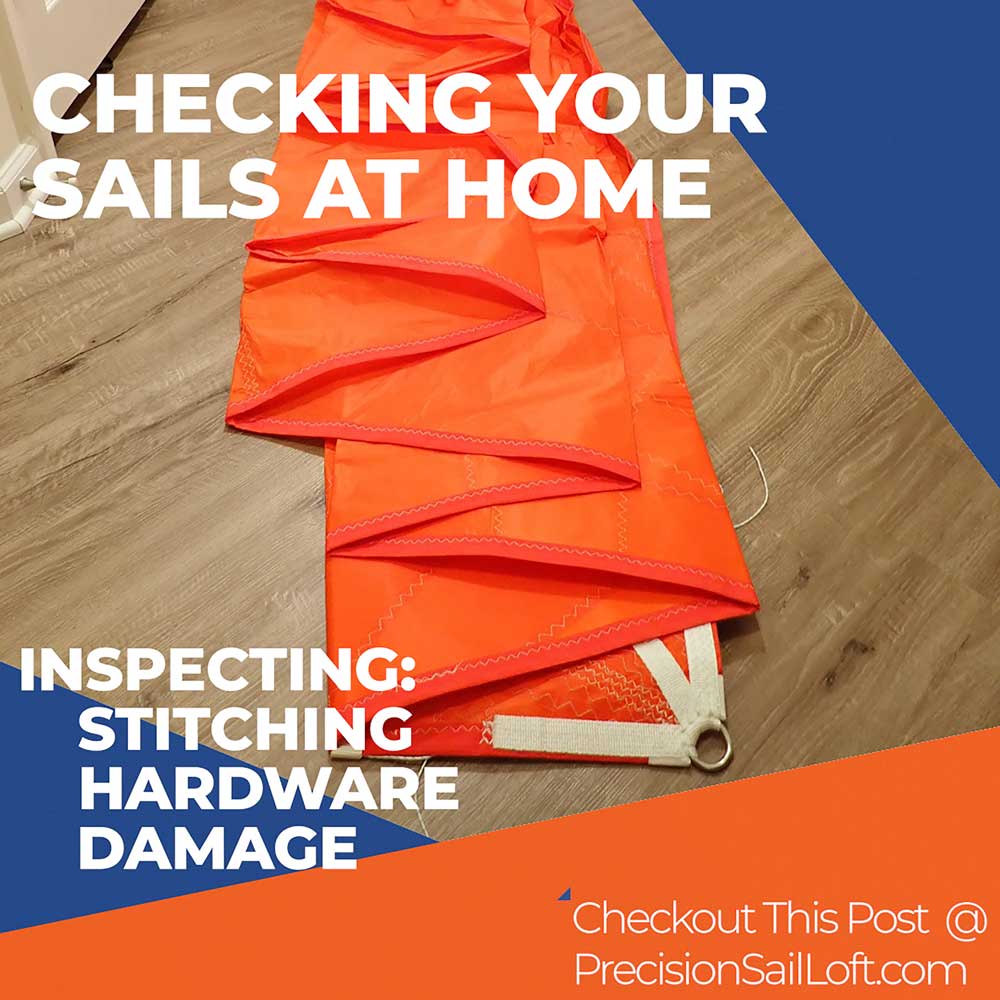Checking Your Sails At Home
With sailing season almost upon those of us living in the northern hemisphere, now is the time to inspect our sails so we can be confident they will survive another season of abuse. Unfortunately, this is not one of the more glamorous or exciting parts of sailing, and for some, it can fall by the wayside, until it is too late. But if you do not mind filling your living room with Dacron for an afternoon, we will show you how to inspect your sails from the comfort of your own couch!
Before you start, you should prepare your “workspace”. This will depend on the size of your sail, but chances are it will be bigger than your room, so you should be prepared to make a bit of a mess. Remove any loose objects from the room, especially anything pointy or sharp that could damage the sail. Once you have cleared away a space, go ahead and open your sail bag. Before things get too hectic, start inspecting the sail as you un-flake it, and cross things off from the checklist below as you do so. We recommend checking the sail over and flaking it into another pile to stay organized.
- Attachment points – Closely inspect any part of the sail that contacts the rigging: corner attachment points, bolt rope, hardware, sliders, and reefing systems. If you see any chafing or damage, assess the severity and repair if needed.
- Sail edges – Check the entire perimeter for evidence of stretching, misshaping, or UV damage.
- Sail shape – Do your best to pull a small section of your sail taught by hand, or you can tackle bigger sections with a little help. You want to look for any sections of the sail that appear “baggy” or “stretched out”. Stretching causes your draft to deepen, reducing the efficiency of your sail’s shape even when trimmed.
- Stitching – UV damage typically affects the stitching of the sail before the cloth. If you notice any of your stitching fraying, check closely to see if there are other stitches that will need repair. You can learn about checking and preventing UV Damage here.
- Tears & Holes – Sails will develop small holes or short tears which can grow into big problems. Many of the smaller issues can be repaired by sewing or using repair tape. However, your can prevent damage caused by rigging by applying spreader patches to areas of the sail most at risk.
- Creases and folds – These are places that are prone to damage as the repeated bending can break down the fibers and stitching of your sail. It is important to fold and store your sails correctly to protect them from wear and tear.
- UV Protection – You should expect some ultraviolet-light damage as a normal course of sailing. If the exposure is too great, you will need professional repairs at least, or possibly a new sail. Learn more about preventing and repairing UV damage here.
- Smell – Mold and fungus have an easily detectable smell, even when not visible. You can learn how to clean your sails here .
- Accessories – If it attaches, blots, clamps or is sewn onto your sail you should check it over. Identification and visuals like draft strips and sail numbers should be checked to see if they are peeling. Batten pockets should have no tears and be able to tension properly. Sliders, reinforcements, headboards, and rings should all be checked over for frayed webbing and stitching.
Some important tips to remember while inspecting your sails
- It is okay to poke, pick, and prod a bit. If your fingernail can easily fray the stitching, or you can feel the sail stretch from a moderate tug, just imagine what the sail might look like after a stormy day on the water. Test the limits of your sail while the stakes are low.
- Use your best judgement. At the end of the day, it’s your sail. If you feel uneasy about the integrity of your sail, get a second opinion. If you do not mind being hard on your sails, and you have a trustworthy motor, go ahead and push them to their limits. But always put your safety, and the safety of others first.
- Once you’ve finished inspecting your sails, write down your findings so you can monitor how any borderline areas progress throughout the season, or, if necessary, give Precision Sails a call to discuss your options for a new sail this season!
Get ahead of the upcoming project
If you notice that your sails make you feel uneasy about the integrity, have borderline areas that need to be monitored, or irreparable tears, now is a great time to get ahead of the possible upcoming project. Spring is here and you can save up to 30% on new sails! Simply request a new quote or let us know if you would like us to update your existing quote.




